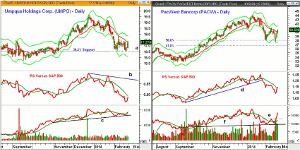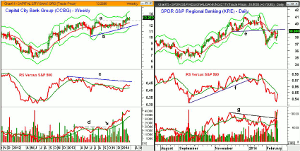The financial sector, of which banks form a sub-sector, has been one of last year’s strongest sectors, and with some regional banks being heavily shorted by traders, MoneyShow’s Tom Aspray goes shopping for potential short-squeeze plays.
More new stock market records were set to start off the week as the Nasdaq 100 reached its highest level since September 2000. Most of the major averages did close below the day’s highs, with the S&P 500 reaching a high of 1858.71, before closing at 1847.61.
One of the best sectors were the banks as the SPDR KBW Bank ETF (KBE) was up 1.49% and the SPDR KBW Regional Bank ETF (KRE) was up 1.91% on the day. There are 81 regional banks in KRE and none of its holdings make up more than 1.9% of the ETF.
There are quite a few of the regional banks that appear to have completed their corrections; some have been heavily shorted by traders. This is reflected not only by the large number of shares sold short but also by their short interest ratios.
This ratio represents how many days of average volume it would take for traders to cover their short position. It is calculated by dividing the number of shares sold short by the average daily volume. These three banks stocks look positive technically, and on further strength, could squeeze those on the short side.
Chart Analysis: Umpqua Holdings Corp. (UMPQ) has a short position of over 24 million shares at the end of January with a short ratio of over 21. It is a $1.91 billion financial holding company with a dividend yield of 3.48%.
- UMPQ hit a high of $19.50 just before Christmas and had a recent low of $16.50.
- This was a drop of over 15% from the highs as the correction has tested the 38.2% Fibonacci support.
- The declining 20-day EMA is now being tested with the quarterly pivot at $18.20.
- Monday’s close was above Friday’s doji high so a high close doji buy signal was triggered.
- The relative performance did confirm the December highs before topping out.
- The RS line is still in a solid downtrend, line b, and is below its WMA.
- The on-balance volume (OBV) held firm on the correction and has turned up from support at line c.
- The daily OBV is now back above its WMA but the weekly is not.
PacWest Bancorp (PACW) is a $1.79 billion bank holding company whose interests are primarily in southern California. There are 12.6 million shares on the short side with a short ratio of just over 24 days.
- PACW peaked in January at $43.68 and hit a low last week of $37.70.
- This was just below the 50% Fibonacci support level and came close to the daily starc- band.
- The close, Monday, was back above its 20-day EMA and the chart appears to show a short-term bottom formation.
- The 61.8% support level is at $36.96.
- The daily relative performance did confirm the recent highs and turned up sharply on Monday, reaching its declining WMA.
- The volume has been very strong over the past few days as the OBV has moved well above the recent high (line e).
- Monday’s close was back above the quarterly pivot at $39.44 with the monthly projected pivot resistance at $41.60. Additional chart resistance is in the $43 area.
NEXT PAGE: 1 More Bank with High Short Interest
|pagebreak|Capital City Bank Group (CCBG) is a bank holding company with interests in Florida, Georgia, and Alabama. There are 878,063 shares sold short with a short ratio of 23 days. Volume is relatively thin at 38K a day.
- The weekly chart shows good support at $12.74 with the 20-week EMA at $12.24.
- The quarterly pivot is at $11.93.
- The weekly relative performance moved back above its WMA in the middle of January and shows a positive formation.
- The RS line has major resistance at line c.
- The weekly OBV broke out to the upside last fall as resistance at line d was overcome.
- The weekly OBV looks very strong and the daily OBV (not shown) is also positive.
- The weekly starc+ band is at $14.28.
The SPDR S&P Regional Banking (KRE) peaked at $41.24 on January 22 and slid to a low of $36.82 in early February. It has a current yield of 1.43%.
- KRE is still 5.7% below its recent high of $41.24.
- The low last week was $37.43, which is the first good level of support.
- The close Monday was right on the quarterly pivot of $38.83 and chart resistance at line e.
- There is additional resistance at $39.63.
- The daily relative performance has reversed sharply to the upside but it will take more time to determine that it is in a clear new uptrend.
- The very heavy volume in the past few days has pushed the OBV well above the resistance at line g.
- The daily OBV is now well above the previous highs but the weekly OBV (not shown) is below its WMA.
What It Means: The further new highs in the NYSE A/D line suggest that pullbacks should be brief and well supported.
Those banks with a high short interest could have additional upside potential and the recent volume has been quite positive.
The more conservative approach would be to buy the SPDR S&P Regional Banking (KRE). The highest risk is in the Capital City Bank Group (CCBG) because of its low volume.
How to Profit: For Umpqua Holdings Corp. (UMPQ), go 50% long at $17.15 and 50% long at $16.96, with a stop at $16.29 (risk of approx. 4.4%).
For PacWest Bancorp (PACW), go 50% long at $40.14 and 50% long at $39.54, with a stop at $37.41 (risk of approx. 6.0%).
For Capital City Bank Group (CCBG), go 50% long at $12.88 and 50% long at $12.65, with a stop at $11.94 (risk of approx. 6.4%).
For SPDR S&P Regional Banking (KRE), go 50% long at $38.63 and 50% long at $37.68, with a stop at $36.53 (risk of approx. 4.2%).












